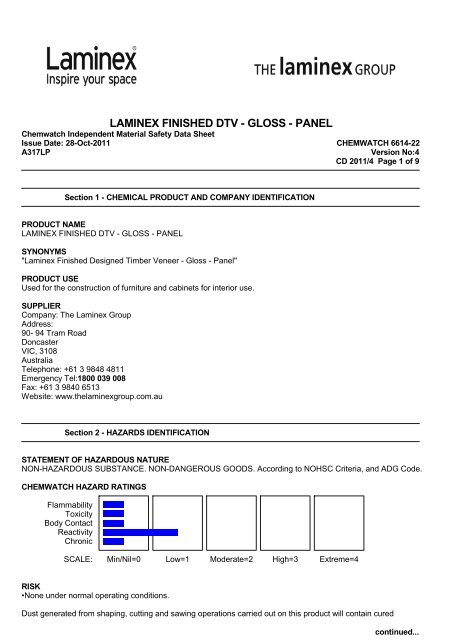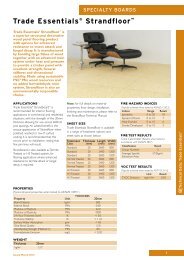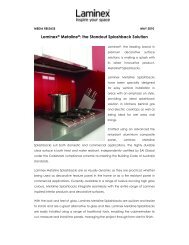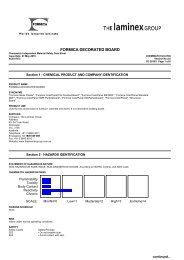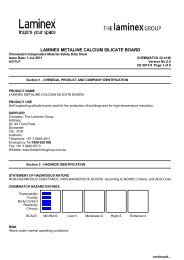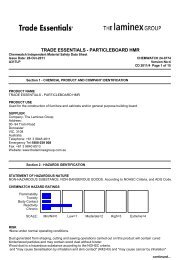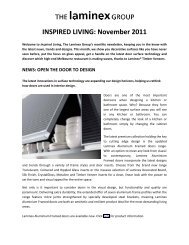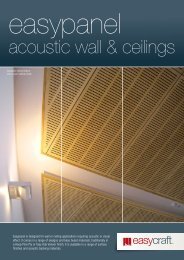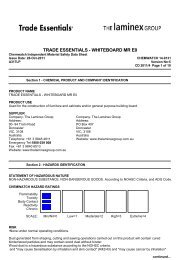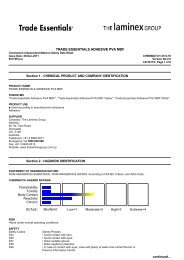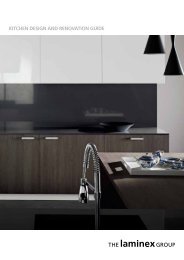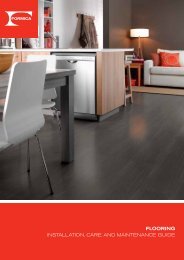Laminex Finished DTV - Gloss - Panel MSDS 6614-22
Laminex Finished DTV - Gloss - Panel MSDS 6614-22
Laminex Finished DTV - Gloss - Panel MSDS 6614-22
Create successful ePaper yourself
Turn your PDF publications into a flip-book with our unique Google optimized e-Paper software.
LAMINEX FINISHED <strong>DTV</strong> - GLOSS - PANELChemwatch Independent Material Safety Data SheetIssue Date: 28-Oct-2011 CHEMWATCH <strong>6614</strong>-<strong>22</strong>A317LPVersion No:4CD 2011/4 Page 1 of 9Section 1 - CHEMICAL PRODUCT AND COMPANY IDENTIFICATIONPRODUCT NAMELAMINEX FINISHED <strong>DTV</strong> - GLOSS - PANELSYNONYMS"<strong>Laminex</strong> <strong>Finished</strong> Designed Timber Veneer - <strong>Gloss</strong> - <strong>Panel</strong>"PRODUCT USEUsed for the construction of furniture and cabinets for interior use.SUPPLIERCompany: The <strong>Laminex</strong> GroupAddress:90- 94 Tram RoadDoncasterVIC, 3108AustraliaTelephone: +61 3 9848 4811Emergency Tel:1800 039 008Fax: +61 3 9840 6513Website: www.thelaminexgroup.com.auSection 2 - HAZARDS IDENTIFICATIONSTATEMENT OF HAZARDOUS NATURENON-HAZARDOUS SUBSTANCE. NON-DANGEROUS GOODS. According to NOHSC Criteria, and ADG Code.CHEMWATCH HAZARD RATINGSFlammabilityToxicityBody ContactReactivityChronicSCALE: Min/Nil=0 Low=1 Moderate=2 High=3 Extreme=4RISK•None under normal operating conditions.Dust generated from shaping, cutting and sawing operations carried out on this product will contain curedcontinued...
LAMINEX FINISHED <strong>DTV</strong> - GLOSS - PANELChemwatch Independent Material Safety Data SheetIssue Date: 28-Oct-2011 CHEMWATCH <strong>6614</strong>-<strong>22</strong>A317LPVersion No:4CD 2011/4 Page 3 of 9Section 5 - FIRE FIGHTING MEASURESEXTINGUISHING MEDIA■ - Foam.- Dry chemical powder.- BCF (where regulations permit).- Carbon dioxide.- Water spray or fog - Large fires only.FIRE FIGHTING■ - Alert Fire Brigade and tell them location and nature of hazard.- Wear breathing apparatus plus protective gloves.- Prevent, by any means available, spillage from entering drains or water courses.- Use water delivered as a fine spray to control fire and cool adjacent area.- DO NOT approach containers suspected to be hot.- Cool fire exposed containers with water spray from a protected location.- If safe to do so, remove containers from path of fire.- Equipment should be thoroughly decontaminated after use.FIRE/EXPLOSION HAZARD■ Combustible. Will burn if ignited.Combustion products include: carbon monoxide (CO), carbon dioxide (CO2), and minor amounts of, hydrogencyanide, other pyrolysis products typical of burning organic material.FIRE INCOMPATIBILITY■ - Avoid contamination with oxidising agents i.e. nitrates, oxidising acids, chlorine bleaches, poolchlorine etc. as ignition may result.HAZCHEMNoneSection 6 - ACCIDENTAL RELEASE MEASURESMINOR SPILLS■ - Clean up all spills immediately.- Secure load if safe to do so.- Bundle/collect recoverable product.- Collect remaining material in containers with covers for disposal.MAJOR SPILLS■ - Clean up all spills immediately.- Secure load if safe to do so.- Bundle/collect recoverable product.- Collect remaining material in containers with covers for disposal.Personal Protective Equipment advice is contained in Section 8 of the <strong>MSDS</strong>.Section 7 - HANDLING AND STORAGEPROCEDURE FOR HANDLING■ - Avoid generating and breathing dust- Avoid contact with skin and eyes.- Wear nominated personal protective equipment when handling.continued...
LAMINEX FINISHED <strong>DTV</strong> - GLOSS - PANELChemwatch Independent Material Safety Data SheetIssue Date: 28-Oct-2011 CHEMWATCH <strong>6614</strong>-<strong>22</strong>A317LPVersion No:4CD 2011/4 Page 4 of 9Section 7 - HANDLING AND STORAGE- Use in a well-ventilated area.- Use good occupational work practices.- Observe manufacturer's storing and handling recommendations.SUITABLE CONTAINER■ No restriction on the type of containers. Packing as recommended by manufacturer. Check all material isclearly labelled.STORAGE INCOMPATIBILITY■ - Avoid reaction with oxidising agents.STORAGE REQUIREMENTS■ Store away from incompatible materials.Section 8 - EXPOSURE CONTROLS / PERSONAL PROTECTIONEXPOSURE CONTROLSSource Material TWA ppm TWA mg/m³ STEL ppm STEL mg/m³ Notes___________ ___________ _______ _______ _______ _______ _______Australia Exposure phenol (Phenol) 1 4 SkStandardsAustralia Exposure xylene (Xylene (o- , 80 350 150 655Standardsm- , p- isomers))Australia Exposure methyl ethyl ketone 150 445 300 890Standards(Methyl ethyl ketone(MEK))Australia Exposure wood dust softwood 5 10 SenStandards(Wood dust (softwood))The following materials had no OELs on our records• urea/ formaldehyde resin: CAS:9011- 05- 6 CAS:39327- 95- 2 CAS:56779- 89- 6 CAS:57608- 68- 1CAS:57657- 45- 1 CAS:57762- 61- 5 CAS:60267- 46- 1 CAS:60831- 80- 3• melamine/ urea/ CAS:25036- 13- 9formaldehyde resin:MATERIAL DATALAMINEX FINISHED <strong>DTV</strong> - GLOSS - PANEL:Not availableWOOD DUST SOFTWOOD:■ It is the goal of the ACGIH (and other Agencies) to recommend TLVs (or their equivalent) for allsubstances for which there is evidence of health effects at airborne concentrations encountered in theworkplace.At this time no TLV has been established, even though this material may produce adverse health effects (asevidenced in animal experiments or clinical experience). Airborne concentrations must be maintained as low asis practically possible and occupational exposure must be kept to a minimum.NOTE: The ACGIH occupational exposure standard for Particles Not Otherwise Specified (P.N.O.S) does NOTapply.Wood dusts produce dermatitis and an increased risk of upper respiratory disease. Epidemiological studiesin furniture workers show an increased risk of lung, tongue, pharynx and nasal cancer. An excess risk ofleukaemia amongst millwrights probably is associated with exposure to various components used in woodpreservation.Impairment of nasal mucociliary function may occur below 5 mg/m3 and may be important in the developmentof nasal adenocarcinoma amongst furniture workers exposed to hardwoods.Certain exotic hardwoods contain alkaloids which may produce headache, anorexia, nausea, bradycardia andcontinued...
LAMINEX FINISHED <strong>DTV</strong> - GLOSS - PANELChemwatch Independent Material Safety Data SheetIssue Date: 28-Oct-2011 CHEMWATCH <strong>6614</strong>-<strong>22</strong>A317LPVersion No:4CD 2011/4 Page 5 of 9Section 8 - EXPOSURE CONTROLS / PERSONAL PROTECTIONdyspnoea.The softwood TLV-TWA reflects the apparent low risk for upper respiratory tract involvement amongstworkers in the building industry. A separate TLV-TWA, for hard woods, is based on impaired nasal mucociliaryfunction reported to contribute to nasal adenocarcinoma and related hyperplasia found in furniture workers.PERSONAL PROTECTIONEYE■ - Safety glasses with side shields.- Chemical goggles.- Contact lenses may pose a special hazard; soft contact lenses may absorb and concentrate irritants. Awritten policy document, describing the wearing of lens or restrictions on use, should be created for eachworkplace or task. This should include a review of lens absorption and adsorption for the class of chemicalsin use and an account of injury experience. Medical and first-aid personnel should be trained in theirremoval and suitable equipment should be readily available. In the event of chemical exposure, begin eyeirrigation immediately and remove contact lens as soon as practicable. Lens should be removed at the firstsigns of eye redness or irritation - lens should be removed in a clean environment only after workers havewashed hands thoroughly. [CDC NIOSH Current Intelligence Bulletin 59], [AS/NZS 1336 or national equivalent].HANDS/FEET■ - Wear chemical protective gloves, eg. PVC.- Wear safety footwear or safety gumboots, eg. Rubber.NOTE:- The material may produce skin sensitisation in predisposed individuals. Care must be taken, when removinggloves and other protective equipment, to avoid all possible skin contact.- Contaminated leather items, such as shoes, belts and watch-bands should be removed and destroyed.OTHER■ - Overalls.- P.V.C. apron.- Barrier cream.- Skin cleansing cream.- Eye wash unit.Avoid breathing dust when sawing or grinding.Wood dusts produce dermatitis and an increased risk of upper respiratory disease. Epidemiological studies infurniture workers show an increased risk of lung, tongue, pharynx and nasal cancer. An excess risk ofleukaemia amongst millwrights probably is associated with exposure to various components used in woodpreservation.Impairment of nasal mucociliary function may occur below 5 mg/m3 and may be important in the development ofnasal adenocarcinoma amongst furniture workers exposed to hardwoods.Certain exotic hardwoods contain alkaloids which may produce headache, anorexia, nausea, bradycardia anddyspnoea.The softwood TLV-TWA reflects the apparent low risk for upper respiratory tract involvement amongst workersin the building industry. A separate TLV-TWA, for hard woods, is based on impaired nasal mucociliary functionreported to contribute to nasal adenocarcinoma and related hyperplasia found in furniture workers.When cutting wear approved dust respirator to avoid inhalation of wood dust created during the cuttingprocess.RESPIRATOR•Type AX-P Filter of sufficient capacity. (AS/NZS 1716 & 1715, EN 143:2000 & 149:2001, ANSI Z88 or nationalequivalent)The local concentration of material, quantity and conditions of use determine the type of personal protectiveequipment required. For further information consult site specific CHEMWATCH data (if available), or yourOccupational Health and Safety Advisor.continued...
LAMINEX FINISHED <strong>DTV</strong> - GLOSS - PANELChemwatch Independent Material Safety Data SheetIssue Date: 28-Oct-2011 CHEMWATCH <strong>6614</strong>-<strong>22</strong>A317LPVersion No:4CD 2011/4 Page 6 of 9Section 8 - EXPOSURE CONTROLS / PERSONAL PROTECTIONENGINEERING CONTROLS■ Engineering controls are used to remove a hazard or place a barrier between the worker and the hazard. Welldesignedengineering controls can be highly effective in protecting workers and will typically be independentof worker interactions to provide this high level of protection.The basic types of engineering controls are:Process controls which involve changing the way a job activity or process is done to reduce the risk.Enclosure and/or isolation of emission source which keeps a selected hazard "physically" away from the workerand ventilation that strategically "adds" and "removes" air in the work environment. Ventilation can removeor dilute an air contaminant if designed properly. The design of a ventilation system must match theparticular process and chemical or contaminant in use.Employers may need to use multiple types of controls to prevent employee overexposure.- Local exhaust ventilation is required where solids are handled as powders or crystals; even whenparticulates are relatively large, a certain proportion will be powdered by mutual friction.- Exhaust ventilation should be designed to prevent accumulation and recirculation of particulates in theworkplace.- If in spite of local exhaust an adverse concentration of the substance in air could occur, respiratoryprotection should be considered. Such protection might consist of:(a): particle dust respirators, if necessary, combined with an absorption cartridge;(b): filter respirators with absorption cartridge or canister of the right type;(c): fresh-air hoods or masks- Build-up of electrostatic charge on the dust particle, may be prevented by bonding and grounding.- Powder handling equipment such as dust collectors, dryers and mills may require additional protectionmeasures such as explosion venting.Section 9 - PHYSICAL AND CHEMICAL PROPERTIESAPPEARANCEMulti-layer wood-based panel. Newly manufactured board or freshly cut surfaces may have a pine/wood odourPHYSICAL PROPERTIESSolid.Does not mix with water.State Solid Molecular Weight Not ApplicableMelting Range (°C) Not Available Viscosity Not AvailableBoiling Range (°C) Not Available Solubility in water (g/L) I mmiscibleFlash Point (°C) Not Available pH (1% solution) Not Applicab leDecomposition Temp (°C) Not Available pH (as supplied) Not A pplicableAutoignition Temp (°C) Not Available Vapour Pressure (kPa) Not ApplicableUpper Explosive Limit (%) Not Available Specific Gravity (water=1) Not AvailableLower Explosive Limit (%) Not Available Relative Vapour Density Not Available(air=1)Volatile Component (%vol) Not Available Evaporation Rate Not ApplicableSection 10 - STABILITY AND REACTIVITYCONDITIONS CONTRIBUTING TO INSTABILITY■ Product is considered stable and hazardous polymerisation will not occur.For incompatible materials - refer to Section 7 - Handling and Storage.continued...
LAMINEX FINISHED <strong>DTV</strong> - GLOSS - PANELChemwatch Independent Material Safety Data SheetIssue Date: 28-Oct-2011 CHEMWATCH <strong>6614</strong>-<strong>22</strong>A317LPVersion No:4CD 2011/4 Page 7 of 9Section 11 - TOXICOLOGICAL INFORMATIONPOTENTIAL HEALTH EFFECTSACUTE HEALTH EFFECTSSWALLOWED■ The material has NOT been classified by EC Directives or other classification systems as "harmful byingestion". This is because of the lack of corroborating animal or human evidence. The material may still bedamaging to the health of the individual, following ingestion, especially where pre-existing organ (eg. liver,kidney) damage is evident. Present definitions of harmful or toxic substances are generally based on dosesproducing mortality rather than those producing morbidity (disease, ill-health). Gastrointestinal tractdiscomfort may produce nausea and vomiting. In an occupational setting however, ingestion of insignificantquantities is not thought to be cause for concern.EYE■ Although the material is not thought to be an irritant (as classified by EC Directives), direct contactwith the eye may produce transient discomfort characterised by tearing or conjunctival redness (as withwindburn).SKIN■ Skin contact is not thought to have harmful health effects (as classified under EC Directives); thematerial may still produce health damage following entry through wounds, lesions or abrasions.INHALED■ The material is not thought to produce adverse health effects or irritation of the respiratory tract (asclassified by EC Directives using animal models). Nevertheless, good hygiene practice requires that exposurebe kept to a minimum and that suitable control measures be used in an occupational setting.- Hazard relates to dust released by sawing, cutting, sanding, trimming or other finishing operations.New boards or freshly cut surfaces may have a pine/wood/solvent odour which will dissipate with ventilation.When cutting, wood dust will be created which is classified as a Hazardous Substance according to thecriteria of NOHSC.Atmosphere should be checked and if necessary suitable arrangements made to reduce the level of vapours inthe breathing zone for persons working in the area.CHRONIC HEALTH EFFECTS■ This manufactured article is considered to have low hazard potential if handling and personal protectionrecommendations are followed.The sealer for the the final topcoat contains toluene diisocyanate, which is s skin sensitiser, but this isexpected to be fully reacted. When cutting new sheets there is a miniscule possibility that free isocyanatemay be available - care should be taken and correct safety procedures followed to minimise exposure.TOXICITY AND IRRITATIONLAMINEX FINISHED <strong>DTV</strong> - GLOSS - PANEL:■ Not available. Refer to individual constituents.WOOD DUST SOFTWOOD:■ unless otherwise specified data extracted from RTECS - Register of Toxic Effects of Chemical Substances.■ Contact allergies quickly manifest themselves as contact eczema, more rarely as urticaria or Quincke'soedema. The pathogenesis of contact eczema involves a cell-mediated (T lymphocytes) immune reaction of thedelayed type. Other allergic skin reactions, e.g. contact urticaria, involve antibody-mediated immunereactions. The significance of the contact allergen is not simply determined by its sensitisation potential:the distribution of the substance and the opportunities for contact with it are equally important. A weaklysensitising substance which is widely distributed can be a more important allergen than one with strongersensitising potential with which few individuals come into contact. From a clinical point of view, substancesare noteworthy if they produce an allergic test reaction in more than 1% of the persons tested.Allergic reactions involving the respiratory tract are usually due to interactions between IgE antibodies andcontinued...
LAMINEX FINISHED <strong>DTV</strong> - GLOSS - PANELChemwatch Independent Material Safety Data SheetIssue Date: 28-Oct-2011 CHEMWATCH <strong>6614</strong>-<strong>22</strong>A317LPVersion No:4CD 2011/4 Page 8 of 9Section 11 - TOXICOLOGICAL INFORMATIONallergens and occur rapidly. Allergic potential of the allergen and period of exposure often determine theseverity of symptoms. Some people may be genetically more prone than others, and exposure to other irritantsmay aggravate symptoms. Allergy causing activity is due to interactions with proteins.Attention should be paid to atopic diathesis, characterised by increased susceptibility to nasal inflammation,asthma and eczema.Exogenous allergic alveolitis is induced essentially by allergen specific immune-complexes of the IgG type;cell-mediated reactions (T lymphocytes) may be involved. Such allergy is of the delayed type with onset up tofour hours following exposure.No significant acute toxicological data identified in literature search.WARNING: This substance has been classified by the IARC as Group 1: CARCINOGENIC TO HUMANS.WARNING: Inhalation of wood dust by workers in the furniture and cabinet making industry has been related tonasal cancer [ I.L.O. Encyclopedia] Use control measures to limit all exposures.Section 12 - ECOLOGICAL INFORMATIONWOOD DUST SOFTWOOD:■ DO NOT discharge into sewer or waterways.EcotoxicityIngredient Persistence: Persistence: Air Bioaccumulation MobilityWater/Soilwood dust softwood No Data No DataAvailable AvailableSection 13 - DISPOSAL CONSIDERATIONS■ - Recycle wherever possible or consult manufacturer for recycling options.- Consult State Land Waste Authority for disposal.- Bury or incinerate residue at an approved site.- Recycle containers if possible, or dispose of in an authorised landfill.Section 14 - TRANSPORTATION INFORMATIONHAZCHEM:None (ADG7)NOT REGULATED FOR TRANSPORT OF DANGEROUS GOODS: ADG7, UN, IATA, IMDGSection 15 - REGULATORY INFORMATIONPOISONS SCHEDULE NoneREGULATIONSRegulations for ingredientsNo data for <strong>Laminex</strong> <strong>Finished</strong> <strong>DTV</strong> - <strong>Gloss</strong> - <strong>Panel</strong> (CW: <strong>6614</strong>-<strong>22</strong>)No data for wood dust softwood (CAS: , Not avail)continued...
LAMINEX FINISHED <strong>DTV</strong> - GLOSS - PANELChemwatch Independent Material Safety Data SheetIssue Date: 28-Oct-2011 CHEMWATCH <strong>6614</strong>-<strong>22</strong>A317LPVersion No:4CD 2011/4 Page 9 of 9Section 16 - OTHER INFORMATIONINGREDIENTS WITH MULTIPLE CAS NUMBERSIngredient Name CASurea/ formaldehyde 9011- 05- 6, 39327- 95- 2, 56779- 89- 6, 57608- 68- 1, 57657- 45- 1,resin 57762- 61- 5, 60267- 46- 1, 60831- 80- 3■ Classification of the preparation and its individual components has drawn on official and authoritativesources as well as independent review by the Chemwatch Classification committee using available literaturereferences.A list of reference resources used to assist the committee may be found at:www.chemwatch.net/references.■ The (M)SDS is a Hazard Communication tool and should be used to assist in the Risk Assessment. Many factorsdetermine whether the reported Hazards are Risks in the workplace or other settings. Risks may be determinedby reference to Exposures Scenarios. Scale of use, frequency of use and current or available engineeringcontrols must be considered.This document is copyright. Apart from any fair dealing for the purposes of private study, research, review orcriticism, as permitted under the Copyright Act, no part may be reproduced by any process without writtenpermission from CHEMWATCH. TEL (+61 3) 9572 4700.Issue Date: 28-Oct-2011Print Date: <strong>22</strong>-Nov-2011This is the end of the <strong>MSDS</strong>.


